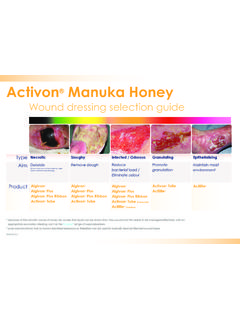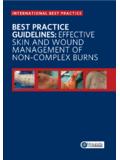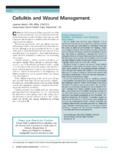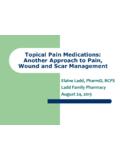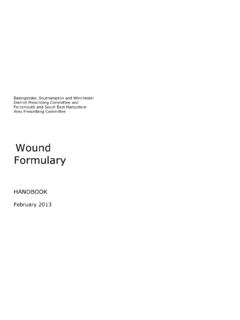Transcription of Manuka honey in wound management: greater …
1 EducationTHIS ARTICLE IS REPRINTED FROM JOURNAL OF wound CARE VOL 25, NO 9, SEPTEMBER 2016 Few involved in wound care will have escaped the considerable interest which has been generated by the resurgence in honey . Equally, there will be many clinicians around the globe who are wondering why all the fuss, as they will have been using honey all along. However, even with the advent of medical-grade honey , combined with considerable research into the numerous potential modes of action, there remains a lingering scepticism regarding the value of honey as a justified, modern intervention in wound purpose of this brief review is to summarise the ongoing chemical, biochemical and microbiological research and to correlate it with clinical outcomes.
2 The purpose being to present the enquiring clinician with an evidence summary with which clinical choices may be made. While much of the early research was into generic honeys, one particular source, Manuka , appears especially effective, and as such this has been the focus of recent of interest: RJW was commission by MA Healthcare and Advancis Medical to write this has been used to treat wounds for ,2 Indeed, until the modern age of evidence-based medicine, honey was so highly regarded as a treatment for wounds that it was accepted as a first-line intervention. It is, however, the scientific and clinical focus on honey which has come about in the past 30 years that has led to the classification of medical-grade honey and the commercial availability of highly regulated products.
3 Biological research into honeyThe literature includes reports on numerous honeys, from different floral sources, for in vitro antimicrobial activity in particular. Due to the pioneering work of the late Peter Molan3 in New Zealand over the past 25 years, it has emerged that of the range of honeys tested, those from one source, Manuka , has particularly high antimicrobial Subsequently many other reports have supported and clarified this activity this is summarised in a review by Carter et It is owing to a series of seminal articles by Molan6 and colleagues7,8 in 1999 that the modern approach to honey in wound can be traced. Until that time there had been debate as to the clinical effects of honey being largely Molan, based upon the considerable evidence available, identified a number of distinct actions of honey (primarily Manuka ) on the wound , namely: Antimicrobial Anti-inflammatoryhoney wound care anti-inflammatory antimicrobial debridement Manuka Debridement Exudate addition Molan6 has listed the numerous advantages of honey based upon the available evidence.
4 Provides a protective barrier to prevent cross-infection Creates an antibacterial moist healing environment Rapidly clears infecting bacteria including antibiotic-resistant strains Has a debriding effect Rapidly removes malodour Hastens healing through stimulation of tissue regeneration Prevents scarring and hypertrophication Minimises the need for skin grafting Is non-adherent and therefore minimises trauma and pain during dressing changes Anti-inflammatory action reduces oedema Has no adverse effect on wound tissues. Reduced costs of dressing materials and anti-bacterial agents More rapid healing Less need for surgical debridement Less need for skin that this list is substantiated by numerous publications at the time of publication, and that numerous additional studies have been added since, it is evident that honey offers considerable honey in wound management : greater than the sum of its parts?
5 R. White,1 PhD, Professor of Tissue Viability, Director DDRC wound Care PlymouthE-mail: 2016 MA Healthcare ltdeducationTHIS ARTICLE IS REPRINTED FROM JOURNAL OF wound CARE VOL 25, NO 9, SEPTEMBER 2016 Manuka honeyWhen considering which floral source honey to research and develop for commercial purposes, a number of important considerations must be made. Accepted that clinical and scientific evidence are essential, it is vital that the honey be available from a sustained, consistent source such that the specifications and quality assurance consistent with a regulated medical product be ,11 It is important that all clinicians using honey , or any other medical device, be aware of the requirements demanded by current regulations.
6 It is in this respect that Manuka honey is the current standard in wound care and thus the focus of this actionTo some degree all honeys have an antimicrobial action as an evolutionary adaptation to prevent spoilage. In many honeys this is based on peroxidise activity. However, this has been attributed to the content of methyl glyoxal (MGO) in Manuka ,13 The activity of Manuka honey is not inhibited by catalase whereas peroxide activity The evidence for all antimicrobial activity in vitro is extensive and well established. In vivo, in the wound itself, Manuka has been shown to be clinically effective in reducing 18 Additionally, Manuka has been shown to be effective against organisms, which are known to be involved in malodour as well as those, in biofilm 23 The action of the honey on various organisms, including antibiotic resistant species15,24,25 has been evaluated in vitro14 and the extensive list of susceptible organisms The mechanisms for this action, including a synergy, have also been ,26 This aspect of Manuka action has recently been examined using 83 clinical isolates of six genera of wound .
7 27 The study involved measurement of both minimum inhibitory concentrations (MICs) and minimum bactericidal concentrations (MBCs) and electron microscopy for evidence of cell lysis. The authors concluded that the findings provide optimism that topical Manuka honey might have a role to play in limiting multidrug resistant Gram-negative bacteria . Indeed, the action of antibiotics against wound pathogens has been shown to be enhanced by the presence of sub-lethal Manuka ).28 The question whether or not resistance might become a problem has been addressed and dismissed at impact of Manuka honeyHealing of chronic wounds Chronicity has been attributed to an uncontrolled inflammation in the wound tissues and to pathogenic organisms.
8 In order to redress the balance, some form of anti-inflammatory, or immunomodulatory action30 is indicated in conjunction with an antimicrobial. The immunomodulatory effect is stimulation or inhibition of the release of cytokines TNFa, Il-1 and Il-6, from monocytes and macrophages depending on the condition of the wound . The combination of the anti-inflammatory, immunomodulatory and antimicrobial actions of Manuka honey has proven effective in the kick-start of delayed healing wounds. The effective use of Manuka honey in a range of chronic wounds has been reported in a number of 35 The clinical research in this area is growing, recent studies have shown that in diabetic foot ulcers Manuka honey represents an effective treatment for NDFU [neuropathic diabetic foot ulcers] leading to a significant reduction in the time of healing and rapid disinfection of ulcers.
9 36 Needless to say, further randomised controlled trials are required to provide substantive evidence. In the meantime there is substantial weak evidence and sufficient support from expert clinicians to indicate the value of Manuka honey in chronic wound action has been reported over the past 20 years and is hypothesised to be owing to a stimulation of plasmin activity in the wound , so denaturing the fibrin which attaches slough to the wound bed. This theory is based upon the known effects of plasminogen activator This mechanism is consistent with autolysis, where the creation of a moist wound environment at the appropriate pH leads to the removal of actionBy concentrating on the known inflammatory mediators active in wounds,37 39 researchers have discovered that Manuka honey is effective in reducing inflammation,40,41 oedema,6,42 and exudate levels via antimicrobial and anti-inflammatory actions.
10 The clinical manifestations of these actions also include pain reduction, reported in many clinical ,44 In addition to overt anti-inflammatory action, Manuka honey has been shown to exert an immunomodulatory effect, for example the stimulation of TNFa, IL-1 and TGFa a by ,45,46 Exudate interactionIt is now known that honey is a biologic wound dressing,14 which has been claimed by Molan and Rhodes to have: 'multiple bioactivities that work in concert to expedite the healing process. The physical properties of honey also expedite the healing process: its acidity increases the release of oxygen from haemoglobin thereby making the wound environment less favourable for the activity of destructive proteases, and the high osmolarity of honey draws fluid out of the wound bed to create an outflow of lymph as occurs with negative pressure wound therapy'.
